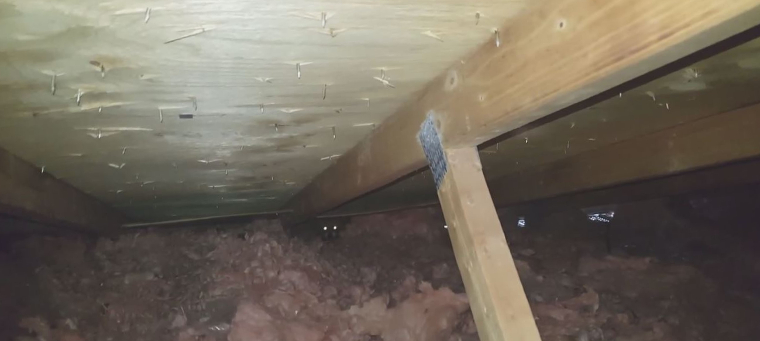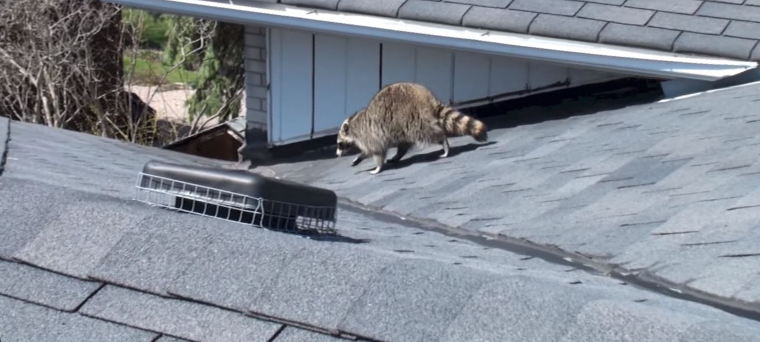-
info@aaanimalcontrol.com
Call us for help in your town
Humane Wildlife Education
I Have a Nest of Raccoons in the Attic, What Next?
Need raccoon removal in your hometown? We service over 500 USA locations! Click here to hire us in your town and check prices- updated for year 2020.
So, you've done your research, followed your ears and nose, and finally located the noise that seemed to be coming from your attic in the middle of the night — a nest of raccoons. They're a noisy bunch, aren't they? They don't smell very pleasant either …

Finding a nest of raccoons in the attic might seem pretty cute at first, but that new family is going to be destructive, costly, and noisy too, and that's before we look at the diseases. (There are a few.) What to do next, however, is a minefield; you have many different options, but the legalities will prevent more than a few.
Here's what we suggest:
How involved would you like to get? If you don't want to get involved at all, leave the job to wildlife rehabilitators. They'll be able to offer same-day “emergency” appointments in most cases, getting the entire job over and done with in just a few short hours.
DIY raccoon removal is well known to take a great deal more time than that. Do you have that kind of time to waste?
Wildlife rehabilitators will remove the raccoons, using whatever tools are necessary. They will take the best, appropriate, and humane course of action next. In some states, you must destroy a raccoon that has been captured in residential areas, because of the high threat of rabies. In others, you can release the creature, but only in specific places. By hiring in the professionals, you won't need to look into the laws and legalities and you won't have to apply for any permits or licenses, which are often required. That's what can take the most time when you're trying to get rid of a rogue raccoon — informing the appropriate authorities that you have a pest control issue and then waiting for them to grant you permission (or not) to deal with it.
If you do not use wildlife rehabilitators, you will need to do the removal work yourself. Thick, rubber gloves are necessary to prevent scratches and bites, even from tiny raccoon kits. Raccoons are a high-risk rabies vector and the disease is primarily passed on to humans and other pets by bites and through scratches — saliva in the mouth will act as the transmitter, passing the virus from the raccoon into the bloodstream of the animal it bites. Animals also lick their claws regularly, so transmission could occur when an infected mammal scratches you.
The animal itself isn't the biggest concern you'll have when getting up close and personal with a family of raccoons. Feces and urine are also responsible for the spread of diseases such as salmonellosis, tularemia, and even raccoon roundworm. These diseases are not always dangerous for someone with a healthy immune system, but for young children, the elderly, and already sick or unwell people, the conditions can be incredibly dangerous and, in some cases, fatal. This means that even the cleanup operation after the raccoon or raccoons have been evicted is going to be a lengthy and exhausting job. You can't go about cleaning up after wild animals in the same way that you can clean up the average spill or mess.
There are numerous problems with attempting to get raccoons out of the attic alone, without the assistance of a wildlife rehabilitator. That's not to say that the job will be impossible, but it will most certainly need much more equipment than what you'd already have in your garden shed.
How to Get Rid of a Raccoon on a Roof
Need raccoon removal in your hometown? We service over 500 USA locations! Click here to hire us in your town and check prices- updated for year 2020.
A raccoon on the roof, sadly, means a raccoon in the attic in almost all cases, although, there's a chance you're on the of the lucky ones who caught the raccoon 'in the act' so to speak — trying to breaking in to your home.

If a raccoon is on the roof, you must go up on the roof. Alternatively, you'll need to hire someone to go up on the roof for you. There are entry points up there — that's what the raccoon was there. It was 'scoping out' your home, seeing where the weak points out, checking out all the little nooks and crannies that will later enable it to break in. There might already be a well-used entry point, especially if the raccoon has been living up there for some time. You will see evidence of this usually — raccoons aren't exactly known for being that tidy and will often leave a string of physical signs in their wake.
Problem #1: There's a family up there.
Once you go looking for evidence, you'll probably find it. When a raccoon chooses to hang out on the roof, it is normally because they have created a nest up in the attic — it is a female raccoon. Sadly, this also means you will have an entire family of animals to get rid of, rather than just one, but does also work in your favor a little. You can try using raccoon eviction fluid to evict them, without having to intervene too much.
Eviction fluid or raccoon eviction fluid is made up of secretions from other animals, usually raccoon males, but also occasionally including the urine of foxes, coyotes, wolves, and other big predators in the wild. When you spray this around, the raccoon might just think that there are predators hanging around — if you smell a coyote, it's a pretty good assumption that a coyote is close by, right? That's what you're hoping for when you use raccoon eviction fluid anyway, and the outcome is for her to run scared, grab her babies, and run. That leaves you free to seal up the holes and make sure she can't get right back in again, before clearing up after her messy ways.
Problem #2: You can't find entry points, but there is evidence of raccoons in the attic.
Just because you haven't found any entry points, doesn't mean they aren't there. Raccoons in the attic have usually gotten in via the roof, but they can also get inside your home in other ways. It is also advisable to check other places, such as the chimney.
Natural, daytime light will help you to find entry points during the day, heading inside the attic and then looking out. You could employ the help of a friend to make it easier. You should do a secondary inspection at night, using a torch too. You will pick up on almost all of the hiding spots if you keep your eyes peeled enough.
Do not assume that the raccoon has already left home just because there is no sign of an entry point or nest, but other physical signs of raccoon activity. It is very common for raccoons to move around, from one den to another, returning to the same ones. They will even share details of den sites and food supplies with each other, especially the females — they love to gossip and share special titbits.
Problem #3: You can find holes, but you can't find the nest or any signs.
Again, this can happen a lot. Having holes in the roof doesn't mean that you have animals living inside your home, but if you don't yet, it will only be a matter of time before something moves in.
If you have holes in the roof that appear to have been made by a wild animal, perhaps a raccoon, you might want to try looking slightly further afield for the nest. If you have already looked in the chimney and are pretty sure they're not hiding down there, perhaps it's time to take a closer look at the attic insulation, or perhaps even down into the cavities of your walls.
Failsafe Approach: Wildlife Rehabilitators
It doesn't matter where in your home a raccoon is hiding, or a nest of raccoons, wildlife rehabilitators will be able to find them. Better than that; they'll be able to remove them and make it look as though they were never there in the first place.
A raccoon problem is not one that we recommend you ignore. A raccoon on the roof means that you already have trouble, or trouble is on the horizon. Prevention is better than cure, so perhaps it's time you looked at your home and prevented wild animals from being able to get inside it.
For more information, you may want to click on one of these guides that I wrote:
How much does raccoon removal cost? - get the lowdown on prices.
How to get rid of raccoons - my main raccoon removal info guide.
Example raccoon trapping photographs - get do-it-yourself ideas.
Raccoon job blog - learn from great examples of raccoon jobs I've done.
Raccoons in the attic - what to do to solve the problem.
I Have a Nest of Raccoons in the Attic, What Next?


















